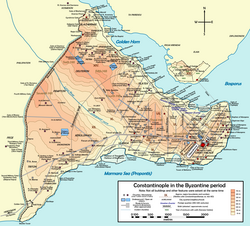Manastır Mosque, Istanbul
| Manastır Mosque | |
|---|---|
Manastır Mescidi | |
 The east side with the apses | |
| Former names | Holy Martyrs Menodora, Metrodora, and Nymphodora (?) Kyra Martha (?) |
| General information | |
| Type | Church |
| Architectural style | Middle Byzantine - Comnenian |
| Address | Turgut Özal Millet Caddesi 183 |
| Town or city | Istanbul |
| Country | Turkey |
| Coordinates | 41°01′02″N 28°55′42″E / 41.01735°N 28.92838°E |
Manastır Mosque (
Location
The medieval structure lies in Istanbul, in the district of Fatih, in the neighborhood of Topkapı, on the south side of Turgut Özal Millet Caddesi, about six hundred metres (2,000 feet) south east of the Topkapı Gate of the city walls. The building can be easily reached from the center by the T1 Tram.
History

The origin of this building, which lies on the seventh hill of Constantinople, is unclear. As its Turkish name suggests, it is possible that it was a small chapel belonging to a monastery, possibly that dedicated to the Holy Martyrs Menodora, Metrodora, and Nymphodora, which existed near the Gate of St. Romanus (today Topkapı, in Turkish “Gate of the gun”), in the neighborhood of Constantinople named ta Elebichou.[1] In the first half of the 14th century, a certain Phokas Maroulas, domestikos of the imperial table, restored the church and dedicated it to the Theotokos, founding a small monastery.[1]

According to another hypothesis, the small building could be an annex of the monastery of Kyra Martha.
Shortly after the
Description
Due to its small dimensions, the building cannot be identified as a church, but rather as an oratory belonging to a monastery. The edifice has a rectangular shape, and nowadays has a single nave with three projecting apses to the east and a narthex to the west. The interior decoration has, for the most part, not survived. Only two hammered carved capitals, part of the triple arcade between the narthex and the naos, are still in place.[1] The roof and the windows have also been modified.[3] Excavations during the 1960s have shown that the building's original plan was more complex.[3] The small church had three naves (possibly surmounted by a dome) and a tripartite bema.[3] On the west side lay an exonarthex topped by a vault, while in the south side a small chapel with esonarthexes on three sides was built.[3] Based on its masonry and plan, the building can be dated to the late eleventh century,[3] although according to other scholars [4] the brickwork texture could also stem from the Palaiologan age (13th–15th century).
References
Sources
- Janin, Raymond (1953). La Géographie Ecclésiastique de l'Empire Byzantin. 1. Part: Le Siège de Constantinople et le Patriarcat Oecuménique. 3rd Vol. : Les Églises et les Monastères (in French). Paris: Institut Français d'Etudes Byzantines.
- Mamboury, Ernest (1953). The Tourists' Istanbul. Istanbul: Çituri Biraderler Basımevi.
- Eyice, Semavi (1955). Istanbul. Petite Guide a travers les Monuments Byzantins et Turcs (in French). Istanbul: Istanbul Matbaası.
- ISBN 978-3-8030-1022-3.

